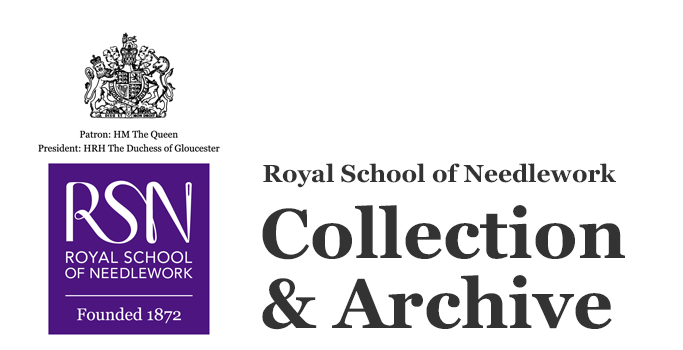Sampler
Object name
Maker
Date made
1806
Place made
Description
Quaker sampler made by Deborah Cockin at Ackworth School in 1806.
Content description
Quaker sampler made by Deborah Cockin at Ackworth School in 1806. Worked entirely in green silk cross stitch on a linen ground, each design is framed by an octagonal medallion. Some of the octagons are regular, some irregular, and a different geometric design is used for each medallion's borders. Around the edge of the piece are half medallions which run off the edge of the design, containing a combination of floral and geometric designs. In the centre are five medallions. The first is a regular octagon with two birds holding branches; below the birds is the text 'A TOKEN OF LOVE 1806'. Beside this is a wreath containing the words 'DC TO MC 1806.' The third is another regular octagon containing a cornucopia with tulips and cornflowers. Two smaller irregular octagons contain a bird in a creeper and a single flower stem.
The lower half of the central area is filled with floral designs and another bird, all of which surround the name 'D Cockin', which is worked in blue thread. Flowers include carnations, cornflowers, and many other generic flower designs.
This sampler was made at Ackworth School, a Quaker school, in 1806. 'D Cockin' is Deborah Cockin, who came from the Cockin family of Doncaster. She was one of six Cockins who attended Ackworth School, having been proceeded by John in 1790, Mary in 1792, Ann in 1794, Joseph in 1797, and Richard in 1801. It is likely that 'DC TO MC 1806' is Deborah referring to herself and Mary. Deborah was a scholar at Ackworth School from 1805-1808. The Cockins appear in the principal list of inhabitants in Doncaster at this time as victuallers, breeches makers, and saddlers.
Ackworth School was founded in 1779 in Pontefract, West Yorkshire for the children of poorer Quakers. Girls at the school were taught to make marking, darning, extract, and medallion samplers. This medallion sampler style is commonly thought to have originated at Ackworth School but was actually occasionally practiced by Quakers in Ireland, England, and colonial America throughout the 18th century before being adopted and popularised by Ackworth. It was taught at a variety of Quaker schools on both sides of the Atlantic from the late 18th century through the first decades of the 19th century. Deborah Cockin's sampler is very typical of Ackworth medallion samplers.
The lower half of the central area is filled with floral designs and another bird, all of which surround the name 'D Cockin', which is worked in blue thread. Flowers include carnations, cornflowers, and many other generic flower designs.
This sampler was made at Ackworth School, a Quaker school, in 1806. 'D Cockin' is Deborah Cockin, who came from the Cockin family of Doncaster. She was one of six Cockins who attended Ackworth School, having been proceeded by John in 1790, Mary in 1792, Ann in 1794, Joseph in 1797, and Richard in 1801. It is likely that 'DC TO MC 1806' is Deborah referring to herself and Mary. Deborah was a scholar at Ackworth School from 1805-1808. The Cockins appear in the principal list of inhabitants in Doncaster at this time as victuallers, breeches makers, and saddlers.
Ackworth School was founded in 1779 in Pontefract, West Yorkshire for the children of poorer Quakers. Girls at the school were taught to make marking, darning, extract, and medallion samplers. This medallion sampler style is commonly thought to have originated at Ackworth School but was actually occasionally practiced by Quakers in Ireland, England, and colonial America throughout the 18th century before being adopted and popularised by Ackworth. It was taught at a variety of Quaker schools on both sides of the Atlantic from the late 18th century through the first decades of the 19th century. Deborah Cockin's sampler is very typical of Ackworth medallion samplers.
Dimensions
width: 57cm
height: 51cm
height: 51cm
Materials
Stitches
Techniques
Motifs
Credit line
Gift of Jean Panter, 2009.
Catalogue number
RSN.1465
© Royal School of Needlework

